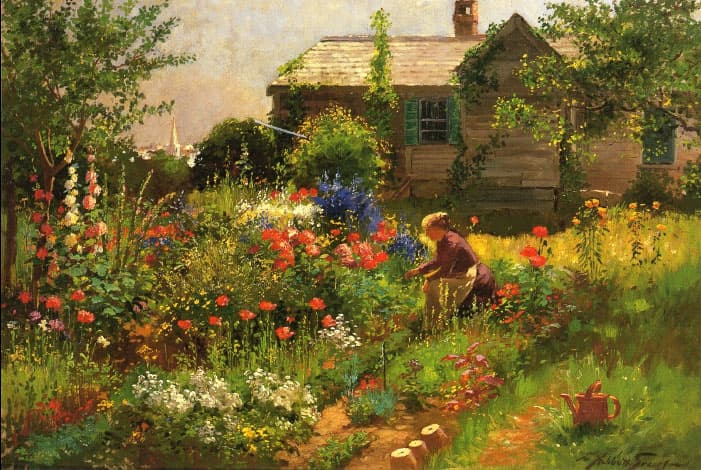Your shopping cart is empty!
Hollyhock "Multicolor" (mix)
Garden hollyhock "Multicolor" (color mix) - Alcea rosea ficifolia.
Origin: Caucasus, the Balkan Peninsula, and the island of Crete.
A perennial plant cultivated as a biennial or annual. Stems are strong and branched from the very base, 80–250 cm tall. Leaves are large, lobed, and serrated at the edges, up to 10 cm across. Stems and leaves are rough and hairy. Flowers are large, single or double, up to 12 cm in diameter, wide bell-shaped, white, pink, red to almost black, gathered in long racemose inflorescences containing up to 150 flowers. Blooms in July–September, in the second year after sowing. Produces abundant seeds. Seed viability lasts 2–3 years. 1.0 g = 70–80 seeds.
Cultivated since 1440.
Location: drought-tolerant. Blooms most profusely in open, sunny areas.
Soil: prefers deeply cultivated, fertile soil with moderate moisture. Dies on very poor, dry, heavy, or waterlogged soils.
Care: in windy areas, tie plants to stakes driven into the ground. After flowering, cut flower stalks down to 30 cm or remove completely. Fertilizing is not required on fertile soils. On poor soils, apply a thin layer of compost a few weeks after planting or feed every 4 weeks with a weak solution of complete mineral fertilizer.
Diseases and pests: susceptible to rust. Yellow or reddish-brown spots and pustules appear on the underside of leaves; pale spots on the upper side; leaves wither and fall off. Remove affected parts immediately; if infection spreads, destroy the plant. Do not plant hollyhocks in the same location for 2 years.
Propagation: by sowing seeds directly into open ground or cold frames in May–June. Use two-year-old seeds for best germination. Transplant in August–September, keeping 50 cm between plants.
Varieties that can bloom in the first year are sown for seedlings in early March and planted outdoors in May. In temperate climates, overwinter under light cover of spruce branches and leaves. When transplanting, keep an intact soil clod around the fleshy roots to ensure rapid growth and good flowering.
Use: for groups, mixed borders, wall and fence decoration, and for cutting — flowers stay fresh for a long time, and buds continue to open.
One of the tallest flowering plants, indispensable in large flower beds for the background. Small groups of hollyhocks can also visually break up flat spaces formed by medium-height plants.
Companions: pairs well with bright annuals (sunflower, cosmos) and tall perennials (rudbeckia, phlox).
Origin: Caucasus, the Balkan Peninsula, and the island of Crete.
A perennial plant cultivated as a biennial or annual. Stems are strong and branched from the very base, 80–250 cm tall. Leaves are large, lobed, and serrated at the edges, up to 10 cm across. Stems and leaves are rough and hairy. Flowers are large, single or double, up to 12 cm in diameter, wide bell-shaped, white, pink, red to almost black, gathered in long racemose inflorescences containing up to 150 flowers. Blooms in July–September, in the second year after sowing. Produces abundant seeds. Seed viability lasts 2–3 years. 1.0 g = 70–80 seeds.
Cultivated since 1440.
Location: drought-tolerant. Blooms most profusely in open, sunny areas.
Soil: prefers deeply cultivated, fertile soil with moderate moisture. Dies on very poor, dry, heavy, or waterlogged soils.
Care: in windy areas, tie plants to stakes driven into the ground. After flowering, cut flower stalks down to 30 cm or remove completely. Fertilizing is not required on fertile soils. On poor soils, apply a thin layer of compost a few weeks after planting or feed every 4 weeks with a weak solution of complete mineral fertilizer.
Diseases and pests: susceptible to rust. Yellow or reddish-brown spots and pustules appear on the underside of leaves; pale spots on the upper side; leaves wither and fall off. Remove affected parts immediately; if infection spreads, destroy the plant. Do not plant hollyhocks in the same location for 2 years.
Propagation: by sowing seeds directly into open ground or cold frames in May–June. Use two-year-old seeds for best germination. Transplant in August–September, keeping 50 cm between plants.
Varieties that can bloom in the first year are sown for seedlings in early March and planted outdoors in May. In temperate climates, overwinter under light cover of spruce branches and leaves. When transplanting, keep an intact soil clod around the fleshy roots to ensure rapid growth and good flowering.
Use: for groups, mixed borders, wall and fence decoration, and for cutting — flowers stay fresh for a long time, and buds continue to open.
One of the tallest flowering plants, indispensable in large flower beds for the background. Small groups of hollyhocks can also visually break up flat spaces formed by medium-height plants.
Companions: pairs well with bright annuals (sunflower, cosmos) and tall perennials (rudbeckia, phlox).

Abbott Fuller Graves.












